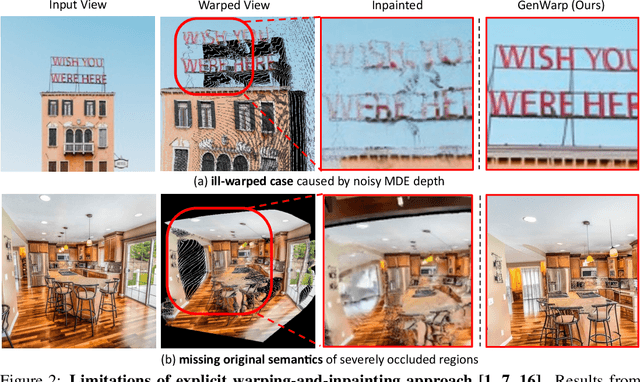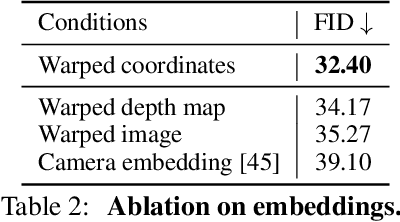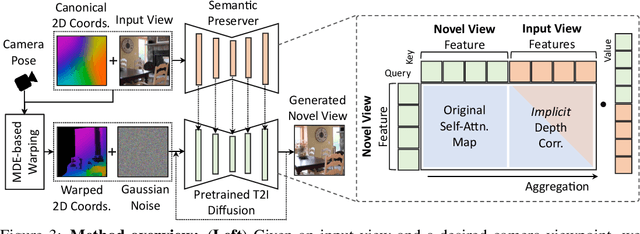Naoki Murata
Forging and Removing Latent-Noise Diffusion Watermarks Using a Single Image
Apr 27, 2025Abstract:Watermarking techniques are vital for protecting intellectual property and preventing fraudulent use of media. Most previous watermarking schemes designed for diffusion models embed a secret key in the initial noise. The resulting pattern is often considered hard to remove and forge into unrelated images. In this paper, we propose a black-box adversarial attack without presuming access to the diffusion model weights. Our attack uses only a single watermarked example and is based on a simple observation: there is a many-to-one mapping between images and initial noises. There are regions in the clean image latent space pertaining to each watermark that get mapped to the same initial noise when inverted. Based on this intuition, we propose an adversarial attack to forge the watermark by introducing perturbations to the images such that we can enter the region of watermarked images. We show that we can also apply a similar approach for watermark removal by learning perturbations to exit this region. We report results on multiple watermarking schemes (Tree-Ring, RingID, WIND, and Gaussian Shading) across two diffusion models (SDv1.4 and SDv2.0). Our results demonstrate the effectiveness of the attack and expose vulnerabilities in the watermarking methods, motivating future research on improving them.
SteerMusic: Enhanced Musical Consistency for Zero-shot Text-Guided and Personalized Music Editing
Apr 15, 2025Abstract:Music editing is an important step in music production, which has broad applications, including game development and film production. Most existing zero-shot text-guided methods rely on pretrained diffusion models by involving forward-backward diffusion processes for editing. However, these methods often struggle to maintain the music content consistency. Additionally, text instructions alone usually fail to accurately describe the desired music. In this paper, we propose two music editing methods that enhance the consistency between the original and edited music by leveraging score distillation. The first method, SteerMusic, is a coarse-grained zero-shot editing approach using delta denoising score. The second method, SteerMusic+, enables fine-grained personalized music editing by manipulating a concept token that represents a user-defined musical style. SteerMusic+ allows for the editing of music into any user-defined musical styles that cannot be achieved by the text instructions alone. Experimental results show that our methods outperform existing approaches in preserving both music content consistency and editing fidelity. User studies further validate that our methods achieve superior music editing quality. Audio examples are available on https://steermusic.pages.dev/.
Transformed Low-rank Adaptation via Tensor Decomposition and Its Applications to Text-to-image Models
Jan 15, 2025Abstract:Parameter-Efficient Fine-Tuning (PEFT) of text-to-image models has become an increasingly popular technique with many applications. Among the various PEFT methods, Low-Rank Adaptation (LoRA) and its variants have gained significant attention due to their effectiveness, enabling users to fine-tune models with limited computational resources. However, the approximation gap between the low-rank assumption and desired fine-tuning weights prevents the simultaneous acquisition of ultra-parameter-efficiency and better performance. To reduce this gap and further improve the power of LoRA, we propose a new PEFT method that combines two classes of adaptations, namely, transform and residual adaptations. In specific, we first apply a full-rank and dense transform to the pre-trained weight. This learnable transform is expected to align the pre-trained weight as closely as possible to the desired weight, thereby reducing the rank of the residual weight. Then, the residual part can be effectively approximated by more compact and parameter-efficient structures, with a smaller approximation error. To achieve ultra-parameter-efficiency in practice, we design highly flexible and effective tensor decompositions for both the transform and residual adaptations. Additionally, popular PEFT methods such as DoRA can be summarized under this transform plus residual adaptation scheme. Experiments are conducted on fine-tuning Stable Diffusion models in subject-driven and controllable generation. The results manifest that our method can achieve better performances and parameter efficiency compared to LoRA and several baselines.
Blind Inverse Problem Solving Made Easy by Text-to-Image Latent Diffusion
Nov 30, 2024



Abstract:Blind inverse problems, where both the target data and forward operator are unknown, are crucial to many computer vision applications. Existing methods often depend on restrictive assumptions such as additional training, operator linearity, or narrow image distributions, thus limiting their generalizability. In this work, we present LADiBI, a training-free framework that uses large-scale text-to-image diffusion models to solve blind inverse problems with minimal assumptions. By leveraging natural language prompts, LADiBI jointly models priors for both the target image and operator, allowing for flexible adaptation across a variety of tasks. Additionally, we propose a novel posterior sampling approach that combines effective operator initialization with iterative refinement, enabling LADiBI to operate without predefined operator forms. Our experiments show that LADiBI is capable of solving a broad range of image restoration tasks, including both linear and nonlinear problems, on diverse target image distributions.
Mitigating Embedding Collapse in Diffusion Models for Categorical Data
Oct 18, 2024



Abstract:Latent diffusion models have enabled continuous-state diffusion models to handle a variety of datasets, including categorical data. However, most methods rely on fixed pretrained embeddings, limiting the benefits of joint training with the diffusion model. While jointly learning the embedding (via reconstruction loss) and the latent diffusion model (via score matching loss) could enhance performance, our analysis shows that end-to-end training risks embedding collapse, degrading generation quality. To address this issue, we introduce CATDM, a continuous diffusion framework within the embedding space that stabilizes training. We propose a novel objective combining the joint embedding-diffusion variational lower bound with a Consistency-Matching (CM) regularizer, alongside a shifted cosine noise schedule and random dropping strategy. The CM regularizer ensures the recovery of the true data distribution. Experiments on benchmarks show that CATDM mitigates embedding collapse, yielding superior results on FFHQ, LSUN Churches, and LSUN Bedrooms. In particular, CATDM achieves an FID of 6.81 on ImageNet $256\times256$ with 50 steps. It outperforms non-autoregressive models in machine translation and is on a par with previous methods in text generation.
Human-Feedback Efficient Reinforcement Learning for Online Diffusion Model Finetuning
Oct 07, 2024Abstract:Controllable generation through Stable Diffusion (SD) fine-tuning aims to improve fidelity, safety, and alignment with human guidance. Existing reinforcement learning from human feedback methods usually rely on predefined heuristic reward functions or pretrained reward models built on large-scale datasets, limiting their applicability to scenarios where collecting such data is costly or difficult. To effectively and efficiently utilize human feedback, we develop a framework, HERO, which leverages online human feedback collected on the fly during model learning. Specifically, HERO features two key mechanisms: (1) Feedback-Aligned Representation Learning, an online training method that captures human feedback and provides informative learning signals for fine-tuning, and (2) Feedback-Guided Image Generation, which involves generating images from SD's refined initialization samples, enabling faster convergence towards the evaluator's intent. We demonstrate that HERO is 4x more efficient in online feedback for body part anomaly correction compared to the best existing method. Additionally, experiments show that HERO can effectively handle tasks like reasoning, counting, personalization, and reducing NSFW content with only 0.5K online feedback.
MoLA: Motion Generation and Editing with Latent Diffusion Enhanced by Adversarial Training
Jun 04, 2024



Abstract:In motion generation, controllability as well as generation quality and speed is becoming more and more important. There are various motion editing tasks, such as in-betweening, upper body editing, and path-following, but existing methods perform motion editing with a data-space diffusion model, which is slow in inference compared to a latent diffusion model. In this paper, we propose MoLA, which provides fast and high-quality motion generation and also can deal with multiple editing tasks in a single framework. For high-quality and fast generation, we employ a variational autoencoder and latent diffusion model, and improve the performance with adversarial training. In addition, we apply a training-free guided generation framework to achieve various editing tasks with motion control inputs. We quantitatively show the effectiveness of adversarial learning in text-to-motion generation, and demonstrate the applicability of our editing framework to multiple editing tasks in the motion domain.
Instruct-MusicGen: Unlocking Text-to-Music Editing for Music Language Models via Instruction Tuning
May 29, 2024



Abstract:Recent advances in text-to-music editing, which employ text queries to modify music (e.g.\ by changing its style or adjusting instrumental components), present unique challenges and opportunities for AI-assisted music creation. Previous approaches in this domain have been constrained by the necessity to train specific editing models from scratch, which is both resource-intensive and inefficient; other research uses large language models to predict edited music, resulting in imprecise audio reconstruction. To Combine the strengths and address these limitations, we introduce Instruct-MusicGen, a novel approach that finetunes a pretrained MusicGen model to efficiently follow editing instructions such as adding, removing, or separating stems. Our approach involves a modification of the original MusicGen architecture by incorporating a text fusion module and an audio fusion module, which allow the model to process instruction texts and audio inputs concurrently and yield the desired edited music. Remarkably, Instruct-MusicGen only introduces 8% new parameters to the original MusicGen model and only trains for 5K steps, yet it achieves superior performance across all tasks compared to existing baselines, and demonstrates performance comparable to the models trained for specific tasks. This advancement not only enhances the efficiency of text-to-music editing but also broadens the applicability of music language models in dynamic music production environments.
GenWarp: Single Image to Novel Views with Semantic-Preserving Generative Warping
May 27, 2024



Abstract:Generating novel views from a single image remains a challenging task due to the complexity of 3D scenes and the limited diversity in the existing multi-view datasets to train a model on. Recent research combining large-scale text-to-image (T2I) models with monocular depth estimation (MDE) has shown promise in handling in-the-wild images. In these methods, an input view is geometrically warped to novel views with estimated depth maps, then the warped image is inpainted by T2I models. However, they struggle with noisy depth maps and loss of semantic details when warping an input view to novel viewpoints. In this paper, we propose a novel approach for single-shot novel view synthesis, a semantic-preserving generative warping framework that enables T2I generative models to learn where to warp and where to generate, through augmenting cross-view attention with self-attention. Our approach addresses the limitations of existing methods by conditioning the generative model on source view images and incorporating geometric warping signals. Qualitative and quantitative evaluations demonstrate that our model outperforms existing methods in both in-domain and out-of-domain scenarios. Project page is available at https://GenWarp-NVS.github.io/.
PaGoDA: Progressive Growing of a One-Step Generator from a Low-Resolution Diffusion Teacher
May 23, 2024Abstract:To accelerate sampling, diffusion models (DMs) are often distilled into generators that directly map noise to data in a single step. In this approach, the resolution of the generator is fundamentally limited by that of the teacher DM. To overcome this limitation, we propose Progressive Growing of Diffusion Autoencoder (PaGoDA), a technique to progressively grow the resolution of the generator beyond that of the original teacher DM. Our key insight is that a pre-trained, low-resolution DM can be used to deterministically encode high-resolution data to a structured latent space by solving the PF-ODE forward in time (data-to-noise), starting from an appropriately down-sampled image. Using this frozen encoder in an auto-encoder framework, we train a decoder by progressively growing its resolution. From the nature of progressively growing decoder, PaGoDA avoids re-training teacher/student models when we upsample the student model, making the whole training pipeline much cheaper. In experiments, we used our progressively growing decoder to upsample from the pre-trained model's 64x64 resolution to generate 512x512 samples, achieving 2x faster inference compared to single-step distilled Stable Diffusion like LCM. PaGoDA also achieved state-of-the-art FIDs on ImageNet across all resolutions from 64x64 to 512x512. Additionally, we demonstrated PaGoDA's effectiveness in solving inverse problems and enabling controllable generation.
 Add to Chrome
Add to Chrome Add to Firefox
Add to Firefox Add to Edge
Add to Edge